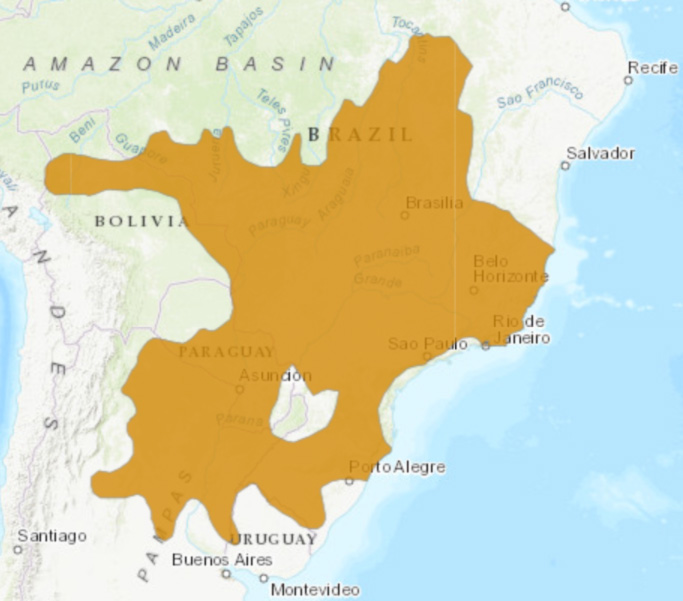Aragona, M., & Setz, E. Z. F. (2001). Diet of the maned wolf, Chrysocyon brachyurus (Mammalia : Canidae), during wet and dry seasons at Ibitipoca State Park, Brazil. Journal of Zoology, 254, 131-136.
Brady, C. A. (1981). The vocal repertoires of the bush dog (Speothos venaticus), crab-eating fox (Cerdocyon thous), and maned wolf (Chrysocyon brachyurus). Animal Behaviour, 29, 649-669.
Bueno, A. D., & Motta, J. C. (2004). Food habits of two syntopic canids, the maned wolf (Chrysocyon brachyurus) and the crab-eating fox (Cerdocyon thous), in southeastern Brazil. Revista Chilena de Historia Natural, 77, 5-14.
Bueno, A. D., & Motta, J. C. (2009). Feeding habits of the maned wolf, Chrysocyon brachyurus (Carnivora: Canidae), in southeast Brazil. Studies on Neotropical Fauna and Environment, 44, 67-75.
Dietz, J. M. (1984). Ecology and social organization of the maned wolf. Smithsonian Contrib. Zool, 392, 1-51.
Jacomo, A. T. D., Kashivakura, C. K., Ferro, C., Furtado, M. M., Astete, S. P., Torres, N. M., Sollmann, R., & Silveira, L. (2009). Home range and spatial organization of Maned Wolves in the Brazilian grasslands. Journal of Mammalogy, 90, 150-157.
Juarez, K. M., & Marinho, J. (2002). Diet, habitat use, and home ranges of sympatric canids in central Brazil. Journal of Mammalogy, 83, 925-933.
Jácomo, A. T. A., Silveira, L., & Diniz, J. A. F. (2004). Niche separation between the maned wolf (Chrysocyon brachyurus), the crab-eating fox (Dusicyon thous) and the hoary fox (Dusicyon vetulus) in central Brazil. Journal of Zoology, 262, 99-106.
Kleiman, D. G. (1972). Social behavior of the maned wolf (Chrysocyon brachyurus) and bush dog (Speothos venaticus): a study in contrast. Journal of Mammalogy, , 791-806.
Paula, R. C., Medici, P., & Morato, R. G. (2008). Plano de Ação para a Conservação do Lobo-Guará – Análise de Viabilidade Populacional e de Habitat. Brasília: Centro Nacional de Pesquisas para Conservação dos Predadores Naturais – CENAP/ICMBio.
Queirolo, D., & Motta-Junior, J. C. (2007). Prey availability and diet of maned wolf in Serra da Canastra National Park, southeastern Brazil. Acta Theriologica, 52, 391-402.
Rodden, M., Rodrigues, F. H. G., & Bestelmeyer, S. (2004). Maned wolf (Chrysocyon brachyurus: Illiger 1815). In C. Sillero-Zubiri, M. Hoffmann & D. W. Macdonald (Eds.), Canids: Foxes, Wolves, Jackals and Dogs. Status Survey and Conservation Action Plan (pp. 26-31). Gland / Cambrigde: IUCN.
Rodrigues, F. H. G., Hass, A., Lacerda, A. C. R., Grando, R. L. S. C., Bagno, M. A., Bezerra, A. M. R., & Silva, W. R. (2007). Feeding Habits Of The Maned Wolf (Chrysocyon Brachyurus) In The Brazilian Cerrado. Mastozoología Neotropical, 14, 37-51.
Sabato, M. A. L., de Melo, L. F. B., Magni, E. M. V., Young, R. J., & Coelho, C. M. (2006). A note on the effect of the full moon on the activity of wild maned wolves, Chrysocyon brachyurus. Behavioural Processes, 73, 228-230.
Santos, E. F., Setz, E. Z. F., & Gobbi, N. (2003). Diet of the maned wolf (Chrysocyon brachyurus) and its role in seed dispersal on a cattle ranch in Brazil. Journal of Zoology, 260, 203-208.
Silva, J. A., & Talamoni, S. A. (2003). Diet adjustments of maned wolves, Chrysocyon brachyurus (Illiger)(Mammalia, Canidae), subjected to supplemental feeding in a private natural reserve, Southeastern Brazil. Revista Brasileira de Zoologia, 20, 339-345.
Silveira, L., Furtado, M. M., Torres, N. M., Sollmann, R., Uhl, G., & Jacomo, A. T. D. A. (2009). Maned Wolf Density in a Central Brazilian Grassland Reserve. Journal of Wildlife Management, 73, 68-71.
Trolle, M., Noss, A. J., Lima, E. D. S., & Dalponte, J. C. (2007). Camera-trap studies of maned wolf density in the Cerrado and the Pantanal of Brazil. Biodiversity and Conservation, 16, 1197-1204.
Veado, B. V. (2007). Parental behaviour in maned wolf Chrysocyon brachyurus at Belo Horizonte Zoo. International Zoo Yearbook, 35, 279-286.
de Melo, L. F., Sábato, M. A., Magni, E. M., Young, R. J., & Coelho, C. M. (2006). Secret lives of maned wolves (Chrysocyon brachyurus Illiger 1815): as revealed by GPS tracking collars. Journal of zoology, 271, 27-36.
